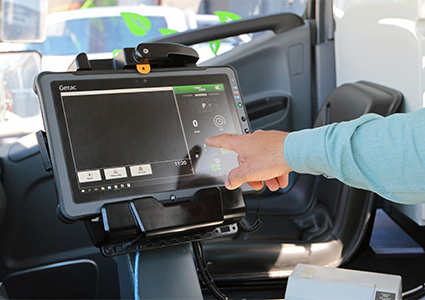
Faster material handling is the answer to efficient warehouse operations. By Paul Waddilove
Today’s global warehousing market is under relentless pressure to meet higher demand and achieve quicker turnaround. Staying competitive requires optimal efficiency in key areas such as logistics and operations.
One of the most substantial cost savings opportunities in production is the ability to efficiently move materials through a manufacturing site or warehouse. This discipline of material handling combines the equipment needed with the warehouse management system (WMS) to ensure seamless material movement.
- However, the movement of significant components through a facility has its share of challenges, some of which include:
- Space limitations due to warehousing cost
- Real-time tracking and inventory management
- Equipment wear and maintenance needs
- Technology integration, updating, and security
- Worker safety as sites pursue a higher throughput
 A truly optimized warehouse ensures the best flow of materials, organized from fast to slow-moving parts, to ensure rapid material flow and order fulfilment. Inaccurate inventory can be costly, but the ability to track and update your inventory in real-time ensures warehouse operatives swiftly convert inventory to goods sold while managing the inventory carrying cost. Significantly, good material handling practices improve worker safety.
A truly optimized warehouse ensures the best flow of materials, organized from fast to slow-moving parts, to ensure rapid material flow and order fulfilment. Inaccurate inventory can be costly, but the ability to track and update your inventory in real-time ensures warehouse operatives swiftly convert inventory to goods sold while managing the inventory carrying cost. Significantly, good material handling practices improve worker safety.
Implementing efficient material handling practices addresses the challenges faced in manufacturing and warehouse applications. Fortunately, a growing number of commercially available solutions can be used to help optimize material handling, capital durability, inventory cost, and worker safety. A great example is the growing use of demountable rugged computing devices fitted to material handling equipment.
How technology and digitalization are shaping the industry
Led by AI and smart manufacturing, industrial manufacturing, operations, and supply chain are transforming like never before. Sensors and data collection from the inventory operations provide a wealth of information that software analyses to influence process changes.
For instance, Dexory’s digital twin warehouse solution collects data from physical warehouse assets and builds a CAD or twin model that engineers can manipulate to optimize inventory and efficiency. The real-world data is digitized, enabling automated analysis.
Just as digital twins aim to reduce the transition time between physical and digital worlds to speed up reaction time, vehicle mounts aim to shorten the physical distance between the operator and technology. Furthermore, these tools deliver additional operational improvements by decentralizing the digital interface.
The importance of material handling solutions
Providing workforces with the latest demountable computer technology ensures they have real-time access to key information wherever they go, helping to increase efficiency and minimize downtime. Mounting solutions also play a key role in the process, giving the flexibility to install digital devices on a wide range of material handling equipment.
Two types of mounting solutions to consider are docking stations and cradles. The primary difference is that cradles are specific to the device and do not replicate the ports, while docking stations provides port replication for the devices as well.
Both vehicle docks and cradles provide a safe and reliable solution for mounting rugged computing devices while affording the operator hands-free data access. These features are critical in many applications, including high-intensity material handling, where an unsecured tablet or laptop can launch across the site, leading to injury.
- In material handling, many applications can effectively leverage vehicle docks or cradles, including:
- Forklifts that travel between storage locations to pick the material using barcodes or RFID scanning
- Specialized function machinery like cranes and hoists that require human operation to transport material safely
- Vehicles that move material to and from the warehouse or plant
Key considerations when choosing material handling equipment
While the mounting locations are flexible, interfering with the handling equipment is a legitimate concern. When designing a mount location, engineers should consider the operator’s way of working and likely movement patterns. For instance, is the device mount within the worker’s reach but out of their normal range of motion or line of sight when performing tasks? Also, does the device mount create potential blind spots? During regular daily operation, what areas may become hidden with the addition of mounted technology devices?
Ease of access and how the operator interacts with the device should be considered when deciding what mount type to use and where it will be mounted. Workers will use the onboard technology multiple times throughout the workday. Is it mounted in a location where access does not impede the user’s typical daily performance?
Another consideration is mount durability. For example, is the application subject to excessive vibration that could dislodge the device from the holder? In addition, shock or vibration fatigue, extreme temperature cycles, and dusty environments could all damage the device. As a result, mounting design should consider likely application environments to guard against damage to the device or connections.
The most impactful benefit vehicle docks and cradles provide for logistics performance is improved operator capability. Moving the technology closer to the operator allows them to scan inventory codes and/or record vehicle performance information more easily. Quicker scans mean faster material processing and higher throughput per hour, all of which leads to optimized operations in an industry where every second counts.
For a list of the sources used in this article, please contact the editor.
Paul Waddilove
www.getac.com/en
Paul Waddilove is Managing Director, UK & Nordics at Getac. Getac Technology Corporation is a global leader in rugged mobile technology and intelligent video solutions, including laptops, tablets, software, body-worn cameras, in-car video, interview rooms, and evidence management software.